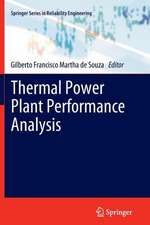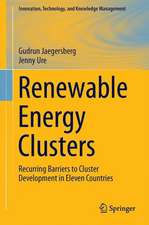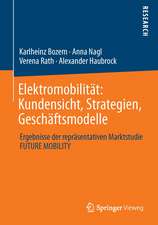Clean Energy from the Earth, Wind and Sun: Learning from Hawaii's Search for a Renewable Energy Strategy
Autor William S. Pintz, Hermina Moritaen Limba Engleză Hardback – 2 dec 2016
Although Hawaii's Clean Energy Initiative is a unique partnership, formulated to meet Hawaii's specific needs and resources, the policy process addressed problems that are common outside the state. While the case study involves clean energy policies, many of the issues are applicable to public policy development topics in other sectors. Examples of these "general interest" policy topics include:
• understanding how the political and socioeconomic climate may influence policy assumptions
• formulating a regulatory and legal framework for monitoring policy compliance
• designing and understanding the implications of subsidy and tax-incentive policies
• managing conflicts with policies in other sectors;
• addressing the interests of existing and future stakeholders;
• creating strategies for public consultation and information dissemination;
• using external expertise from government agencies, academic institutions and private consultants;
• designing performance and evaluation metrics for measuring progress.
The book is intended for use in graduate and senior undergraduate courses dealing with the formulation, implementation and impact of public policy. It also provides researchers involved in the development and implementation of clean energy with a guide to the hurdles likely to be encountered in moving innovation from the technical sphere to the practical real world and how to overcome them. Professional policymakers may benefit from an example of a process to create a workable clean energy policy.
| Toate formatele și edițiile | Preț | Express |
|---|---|---|
| Paperback (1) | 566.46 lei 38-44 zile | |
| Springer International Publishing – 29 apr 2018 | 566.46 lei 38-44 zile | |
| Hardback (1) | 643.99 lei 3-5 săpt. | |
| Springer International Publishing – 2 dec 2016 | 643.99 lei 3-5 săpt. |
Preț: 643.99 lei
Preț vechi: 757.63 lei
-15% Nou
Puncte Express: 966
Preț estimativ în valută:
123.22€ • 129.00$ • 101.96£
123.22€ • 129.00$ • 101.96£
Carte disponibilă
Livrare economică 15-29 martie
Preluare comenzi: 021 569.72.76
Specificații
ISBN-13: 9783319486765
ISBN-10: 3319486764
Pagini: 187
Ilustrații: XX, 175 p. 13 illus. in color.
Dimensiuni: 155 x 235 x 16 mm
Greutate: 0.52 kg
Ediția:1st ed. 2017
Editura: Springer International Publishing
Colecția Springer
Locul publicării:Cham, Switzerland
ISBN-10: 3319486764
Pagini: 187
Ilustrații: XX, 175 p. 13 illus. in color.
Dimensiuni: 155 x 235 x 16 mm
Greutate: 0.52 kg
Ediția:1st ed. 2017
Editura: Springer International Publishing
Colecția Springer
Locul publicării:Cham, Switzerland
Cuprins
Introduction: Roots, Vision and Strategy.- Hawaii Policy Background.- Anatomy of a Policy: Assumptions, Policies, and Initial Resource Assessments.- Negotiations: Politics, Intentions, and Institutional Capacity.- Connecting the Dots: Early Implementation of HCEI Electricity Goals.- Unconnected Dots: Early Implementation of HCEI Surface Transportation Goals.- Environmental Implications and Other Disconnects.- Year of Uncertainty and Surprise.- Taking Stock.
Notă biografică
William Pintz is a resource economist who for over 30 years was involved in energy policy analysis and resource assessment. Prior to his retirement in 2012, Pintz served as a senior resource planner with Hawaiian Electric Company where he reported directly to the executive vice president on the implications of emerging public policy questions and on assessments of renewable energy resources. He served as coordinator of HECO's climate change task force and was a founding member of the Hawaii Energy Policy Forum.
Hermina Morita has been a leader in Hawaii’s energy sector for over 20 years, having served as the Chair of the Hawaii Public Utilities Commission (PUC) from 2011 to 2015 and as a member of the Hawaii House of Representatives, from 1996 and 2011. As the Chair of the House Committee on Energy and Environmental Protection for 13 years, Morita authored many of Hawaii’s most significant energy and environmental laws. Now semi-retired, Morita nowworks as an independent consultant on energy and environmental matters, writes a blog called Energy Dynamics and is a member on the Hawaii Energy Policy Forum, a collaboration to advance Hawaii’s clean energy transformation.
Textul de pe ultima copertă
This book documents the socio-environmental context and early history of Hawaii's attempt to substitute renewable energy sources and energy efficiency measures for oil imports. It identifies areas of policy formulation where clean energy strategies were effective and areas where the state's policy strategy was either inappropriate or constrained by political or institutional factors.
Although Hawaii's Clean Energy Initiative is a unique partnership, formulated to meet Hawaii's specific needs and resources, the policy process addressed problems that are common outside the state. While the case study involves clean energy policies, many of the issues are applicable to public policy development topics in other sectors. Examples of these "general interest" policy topics include:
• understanding how the political and socioeconomic climate may influence policy assumptions
• formulating a regulatory and legal framework for monitoring policy compliance
• designing and understanding the implications of subsidy and tax-incentive policies
• managing conflicts with policies in other sectors;
• addressing the interests of existing and future stakeholders;
• creating strategies for public consultation and information dissemination;
• using external expertise from government agencies, academic institutions and private consultants;
• designing performance and evaluation metrics for measuring progress.
The book is intended for use in graduate and senior undergraduate courses dealing with the formulation, implementation and impact of public policy. It also provides researchers involved in the development and implementation of clean energy with a guide to the hurdles likely to be encountered in moving innovation from the technical sphere to the practical real world and how to overcome them. Professional policymakers may benefit from an example of a process to create a workable clean energy policy.
Although Hawaii's Clean Energy Initiative is a unique partnership, formulated to meet Hawaii's specific needs and resources, the policy process addressed problems that are common outside the state. While the case study involves clean energy policies, many of the issues are applicable to public policy development topics in other sectors. Examples of these "general interest" policy topics include:
• understanding how the political and socioeconomic climate may influence policy assumptions
• formulating a regulatory and legal framework for monitoring policy compliance
• designing and understanding the implications of subsidy and tax-incentive policies
• managing conflicts with policies in other sectors;
• addressing the interests of existing and future stakeholders;
• creating strategies for public consultation and information dissemination;
• using external expertise from government agencies, academic institutions and private consultants;
• designing performance and evaluation metrics for measuring progress.
The book is intended for use in graduate and senior undergraduate courses dealing with the formulation, implementation and impact of public policy. It also provides researchers involved in the development and implementation of clean energy with a guide to the hurdles likely to be encountered in moving innovation from the technical sphere to the practical real world and how to overcome them. Professional policymakers may benefit from an example of a process to create a workable clean energy policy.
Caracteristici
Shows potential sources of success and failure in clean energy strategy Describes problems and solutions in interfacing policies at different geographical scales Offers advice on the role of nongovernmental organizations (NGOs) in energy-policy formulation Demonstrates the role of public opinion and cultural factors in the field of renewable resources Alerts readers to the possible impact of events in other energy systems, such as oil, on policy assumptions concerned with renewable energy Includes supplementary material: sn.pub/extras





























